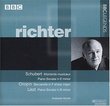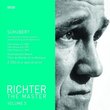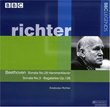| All Artists: Sviatoslav Richter Title: Schubert: Piano Sonatas D664,D784 Members Wishing: 0 Total Copies: 0 Label: Regis Records/Premiere Release Date: 5/29/2007 Album Type: Import Genre: Classical Styles: Forms & Genres, Sonatas, Historical Periods, Modern, 20th, & 21st Century, Romantic (c.1820-1910) Number of Discs: 1 SwapaCD Credits: 1 |
Search - Sviatoslav Richter :: Schubert: Piano Sonatas D664,D784
 | Sviatoslav Richter Schubert: Piano Sonatas D664,D784 Genre: Classical
|
Larger Image |
CD DetailsSimilar CDs |
CD ReviewsLive Schubert from 1979, when Richter had no peer Santa Fe Listener | Santa Fe, NM USA | 08/16/2009 (5 out of 5 stars) "At the pinnacle of Schubert playing I would place Schnabel and Richter, so I'm surprised that these two readings are new to me. Richter made several recordings of both sonatas. This pairing appeared on Melodiya (my CD has a different cover than that pictured by Amazon), deriving from live concer recordings from a Feb. 1979 appearance in Tokyo (Feb 1 for D. 664, feb. 7 for d. 784). A now-deleted Olympia CD contains the same pairing. To finish with the basics, the sound is quite good but very close, so a certain hardness in the piano, and also in Richter's touch during loud passages, is present. As Richter collectors know, it's worth seeking uot the live recordings that feature either good sound or a good piano.
Richter performed a great deal of schubert and must have felt that he had found the key to his piano sonatas. That key is concentrated in the first movements, which for Richter are broad, reflective, and often melancholy. His view of the Scherzos is usually Beethovenesque -- early to middle Beethoven, that is, with plenty of thunder. (Neither of these sonatas has a Scherzo.) The finales are approached as the sunniest movements, a release from inwardness and struggle in the previous movements. In the finales richter's touch is almost the same as what he uses in Mozart. I know I am tossing generalities around, but the profile of richter's Schubert seems to follow the pattern I've described. If your standard for the A major Sonata D. 664 is Kempff's graceful, light-textured eading, you'll find that Richter alternates between serene quietness and an almost threatening attack in the finale. It's not in his nature to let Schubert be naive and cheerful. The A minor Sonata D. 784 is more dramatic, and many pianists have brought out its heroism and strength. Richter is particularly forceful, but what really sets him apart is the rightness of his phrasing, which can make time stand still when Schubert is most meditative. the great opening movement of this sonata is a perfect example and could serve as a touchstone for Richter's entire approach -- his sudden flashes of fierce volatility could have come from no one else. The Andante is hesitant and troubled, taken as a continuation of the mood established in the first movement. The finale is played for light and shade, the first theme being propulsive and stormy, the second flowing and relaxed. In short, a splendid example of how Richter, unique among his peers, could find depth and drama beneath the simplicity of Schubert's surface. Highly recommended." |

 Track Listings (8) - Disc #1
Track Listings (8) - Disc #1



